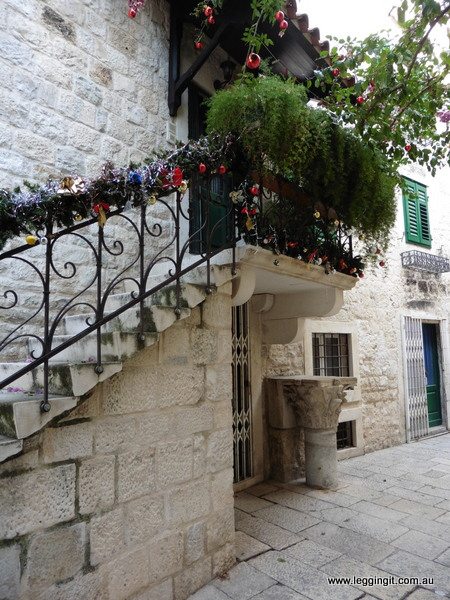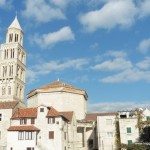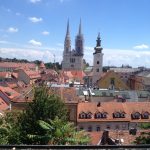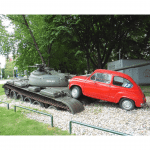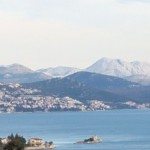Today we took a Split Walking Tour around Diocletian’s Palace in Split. It’s the place where modern day Split evolved from. After paying our 100 kuna (about $19.40 Aus) each at the tour office we met up with our guide Darko, at the city’s Golden gate.
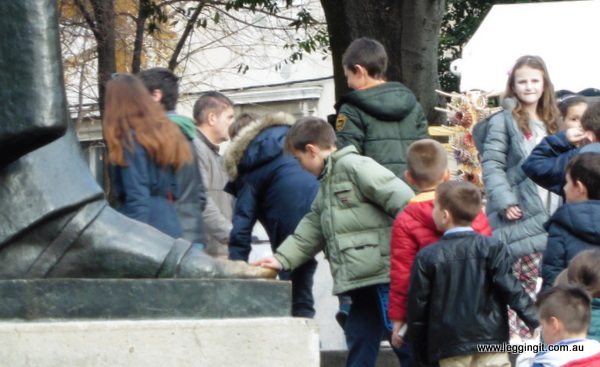
Just outside the golden gate is the massive bronze statue of Gregor Ninsky. He’s the priest who advocated for church services to be held in Croatian rather than Latin, which nobody understood. He’s a Croatian legend and people rub his toe for good luck.
The rubbing of the toe for good luck supposedly refers to a local legend that a local milkmaid dropped a milk churn which landed on the toe. The milk didn’t spill and the milk maid was able to sell the milk at the market.
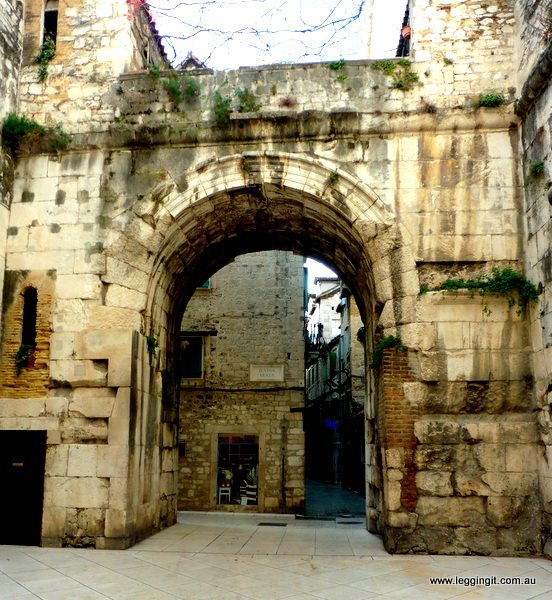
Passing through the golden gate we entered the palace which Diocletian the Roman Emperor built to retire to. The site was chosen well as the city of Solin protected the rear and Diocletian had his own army employed in a lucrative cloth dying business within the place. The streets were originally the width of ten men shoulder to shoulder. It was definitely a show of Roman might and said a lot about Diocletian as a man. Diocletian originated from Solin, near modern day Split, so during his reign he decided to get rid of all the people living in this area and build his retirement home here. It wasn’t any ordinary home however but a huge palace with protective walls on three sides.
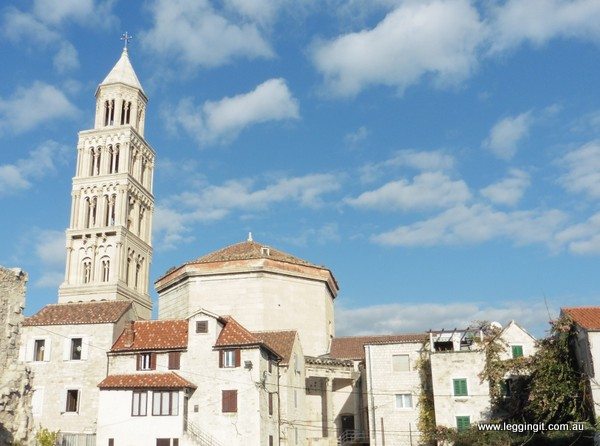
Half of the palace was just his private residence and it contained his mausoleum, temple of Jupiter, and temple of Venus. He built his mausoleum whilst he was still alive just to make sure it was built right. Darko pointed out that what seemed like a simple dot dash pattern around the tomb was actually a winning combination of a roman game played with bones. Diocletian was trying to stack the odds in his favour. He wouldn’t have been too happy that after his death a bath house was built next to his mausoleum, the mosaic floor of which remains today. Darko told us some intriguing stories about Diocletian, and the Roman Empire in Dalmatia. Up until his death Diocletian was still a man of immense power.
It was interesting standing in the remains of the building which served as his dining room and hearing how lavish feasts of thirty courses were laid on to guests who’d be reclining on couches. Thirty courses is just unbelievable and smacks of excess. The bizarre part was learning how in the next room, “The Vomitorium”, a slave would tickle the inside of guests throats with an ostrich feather causing them to vomit. In Diocletian’s time it was considered bad manners and an insult to the host not to eat every course.
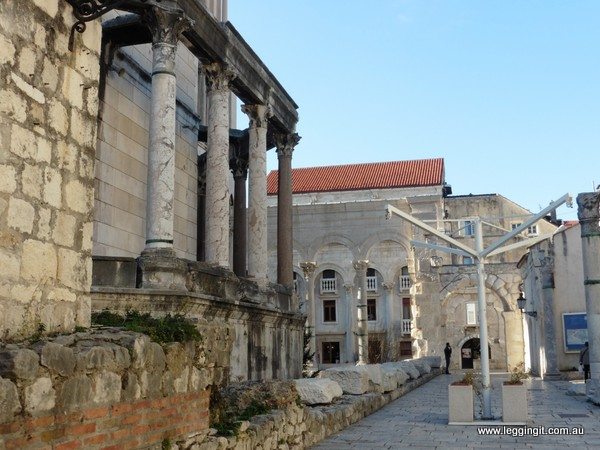
Some of the buildings have remained, such as Diocletian’s mausoleum,which is now the Cathedral of St Domnius, whilst others have been covered by later medieval or more modern buildings. Some buildings even include the roman ruins into their architecture. It’s intersecting looking through the front windows of the bank where a lady leans on a roman column waiting to be served.
After the fall of the Roman Empire and the subsequent spread of the Croats much of the former palace was converted into a rambling medieval city. The wide streets were replaced with streets just wide enough for two donkeys. Just inside the Golden gate the wide street finishes and the narrow streets of the medieval city starts. However, the wider roman street is still visible in some areas especially around Diocletian’s mausoleum.
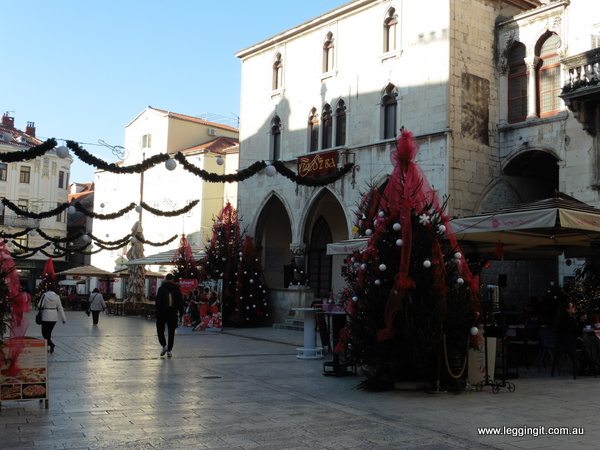
The architecture of the medieval city shows a style which is quite different, from the older roman era, such as ornate curved windows and carved doorways. One strange addition to the front of buildings which intrigued us was a brick extending from the wall on either side of windows. We’d seen them on a few buildings and although they had a hole on the centre they weren’t positioned to be used as a lifting point. Darko explained that in medieval times the windows were half glassed with the bottom open to allow the breeze to pass through. During the hot summer months residents would put a stick between these two projections and drape a wet sheet over it. The wind passing through the wet sheet would act as air conditioning, cooling the rooms.
Looking around the old buildings we wondered why they weren’t blackened by pollution like many other old city’s. Darko pointed out that laser cleaning had been used to remove the filth and leave the structures the way they would’ve looked like when they were new.
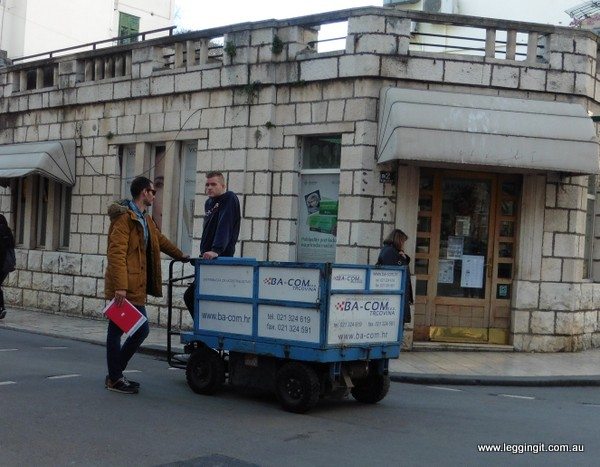
After an enjoyable two hours wandering around this beautiful city our time was up. Darko had told us so much about the city and Diocletian’s palace. We’d learnt some of the history of Splits archaeological history and how the city was currently trying to conserve the older buildings. Where once petrol vehicles were plying the streets in the old city, coughing out pollution now electric carts known locally as the ” electric donkey” rumble through the streets. Darko had pointed out places to further explore around the city and areas around Dalmatia to visit. We’d also learnt some of the history of Dalmatia and how a humble sheep the “Dolma” had given a name to the region.
So after saying goodbye to Darko, we thought what do you in Split on a warm winters day? Head for the Riva, the long strip facing the harbour, and enjoy a drink overlooking the same waters that Diocletian would’ve looked across almost 1700 years ago.
